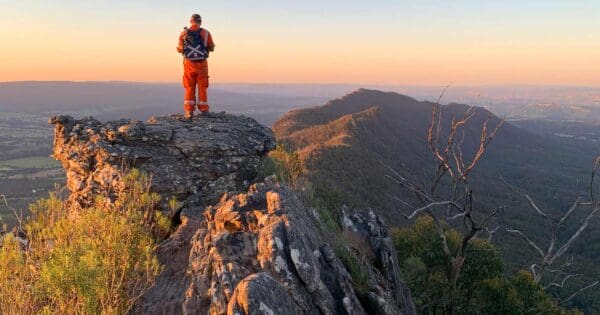A Climb Through Australia’s Highest Peaks
Australia may not boast mighty Himalayas or soaring Andes, but beneath its sun-kissed coastlines and vast outback lie diverse landscapes hiding some hidden gems. For the adventurous souls among us, these gems come in the form of majestic mountains, each state crowned with a peak waiting to be explored. Today, we embark on a virtual expedition, scaling the highest points in each Australian state.
New South Wales – Mt Kosciuszko (2,228m)

Our journey begins at the sometimes snowy speak of Mount Kosciuszko, the undisputed king of Aussie altitude. Nestled in the Snowy Mountains, Mt Kosciuszko stands tall at 2,228 meters, offering breathtaking vistas across alpine valleys and pristine lakes. Winter blankets the peak in a glistening coat, calling skiers and snowboarders to carve their tracks, while summer reveals a paradise for hikers and nature lovers.
Several trails lead to the 2,228-meter summit, two popular options starting at either Thredbo or Charlotte Pass. From Thredbo, follow the Mount Kosciuszko Summit Walk or take the scenic Kosciuszko Chairlift for a head start, followed by a 13-kilometer return hike. Expect sweeping views of alpine valleys and glacial lakes. Charlotte Pass to Mount Kosciuszko Summit offers a slightly longer hike (18.5-kilometer return) but more wilderness-focused ascent through snow gum forests and wildflower meadows. Both trails are challenging, requiring good fitness and thorough preparation. For those seeking a multi-day adventure, you may want to consider embarking on Australia’s 16 highest peaks circuit. A stunning certain across the rooftop of Australia. The best time to hike is late spring to early autumn when the snow melts and conditions are favorable.
Victoria – Mt Bogong (1,986m)

Next, we head south to Victoria, where Mount Bogong reigns supreme at 1,986 meters. Part of the Australian Alps, Bogong is a hiker’s haven, with well-marked trails winding through fields of wildflowers and ancient snow gums. Summit seekers can test their mettle on the challenging Staircase Track, rewarded with panoramic views of Victoria’s rugged beauty.
The Staircase Spur and Eskdale Spur trails, popular routes to Mount Bogong’s summit, can be accessed via Mountain Creek Campground, a charming campsite nestled within the picturesque Alpine National Park. Located just 12km from the town of Mount Beauty, it offers convenient access to both the mountain and other nearby attractions.
Tasmania – Mt Ossa (1,617m)

The island state of Tasmania throws a curveball with its highest peak, Mount Ossa. Rising 1,617 meters from the Cradle Mountain-Lake St Clair National Park, Ossa is shrouded in misty wilderness, a haven for rare flora and fauna. The Overland Track, a multi-day trek through glacial valleys and towering forests, culminates in a challenging scramble to the summit, where the payoff is a mosaic of untouched wilderness. Access to Mount Ossa is via the Overland Track, a incredible 65km walking trail between Cradle Mountain and Lake Sinclair, which takes about six days to complete. You can read my 8-day trip report here.
Queensland – Mt Bartle Frere (1,611m)

From icy heights, we descend to the lush tropics of Queensland, where Mount Bartle Frere (South Peak) claims the throne at 1,611 meters. Located in the World Heritage-listed Wet Tropics of Queensland, this peak is a biodiversity hotspot, its rainforest cloaked in emerald vines and echoing with the calls of exotic birds. Reaching the summit requires navigating dense jungle trails, but the reward is a panorama of the Coral Sea and lush rainforest stretching forever.
Two paths lead to the peak of Mount Bartle Frere, each offering a unique approach to this majestic climb. The most frequented route starts at the Josephine Falls car park. Nestled 31 kilometers northwest of Innisfail, this convenient access point boasts a paved road, making it an ideal choice for those seeking a smoother journey.
Australian Capital Territory – Bimberi Peak (1,912m)

Rising proudly at 1,912 meters within the Brindabella Ranges, Bimberi Peak takes the honor of being the highest point in the Australian Capital Territory. Straddling the border between the ACT and New South Wales, it’s a symbol of both stunning natural beauty and cultural significance. Bimberi Peak holds particular reverence for the Ngarigo and Ngunnawal people, with its name translating to “big mountain” in their language. This connection to the land adds a deeper layer to the experience of climbing its slopes.
For the endurance enthusiasts: Tackle the 50km Mount Bimberi Walk, starting at the historic Orroral Valley Tracking Station. This former NASA outpost, once home to a towering antenna watching over satellites, now offers a gateway to breathtaking views and challenging trails. For those seeking a taste of the wild: Embark on the 22km Murray Gap Trail, accessible via Pockets Saddle Road in Kosciuszko National Park. Remember, this scenic route involves 36km of unsealed roads, which might be closed in winter. For a shorter approach, there’s a 22km route from the west.
Northern Territory – Mt Zeil (1,531m)

The vast expanses of the Northern Territory hold Mount Zeil, a 1,531-meter sandstone giant nestled in the West MacDonnell Ranges. This ancient monolith, sacred to the Arrernte people, towers over desert plains and gorges, offering a glimpse into the heart of Australia’s red center. Trekking to the summit is a journey through time, traversing ancient rock formations and witnessing the stark beauty of the outback.
Reaching Mt Zeil, the Northern Territory’s tallest peak, is easiest through the privately-run Mt Zeil Wilderness Park. This outback haven offers 13 secluded bush campsites, perfect for those seeking peace and adventure amidst stunning desert landscapes.
South Australia – Mt Woodroffe (1,435m)

South Australia’s crown jewel is Ngarutjaranya (formerly Mount Woodroffe), a 1,435-meter peak in the Musgrave Ranges, just below the Northern Territory border in Anangu Pitjantjatjara Yankunytjatjara (APY) land. This spiritual sanctuary boasts breathtaking views of the rugged desert landscape and is home to an abundance of unique flora and fauna. Reaching Ngarutjaranya requires special permission and cultural sensitivity, ensuring a respectful exploration of this sacred site.
Permits for independent Ngarutjaranya climbs are scarce due to its protected status. Diverse Travel Australia hosts a yearly Ngarutjaranya climbing tour in May, granting access from Uluru with a permit included. At this time, all Tourism, Business & Commercial activities on the APY Lands are suspended until further notice.
This suspension also applies to South Australia’s second highest peak, Mount Morris, which is around 1,251 metres high. From public information, it appears that the eight highest peaks in South Australia are all in the Musgrave Ranges, near the border with the Northern Territory. As such, I would expect these same permit considerations to apply. Your next available option is St Mary Peak (1,171m) in the Flinders Ranges. However, this peak is central to the Adnyamathanha creation story. For this reason the Adnyamathanha people of the Flinders Ranges would prefer that visitors do not climb to the summit of the peak. The shorter option to Tanderra Saddle also affords spectacular views.
Western Australia – Mt Meharry (1,253m)

Finally, we land in Western Australia, where Mount Meharry (Wirlbiwirlbi) takes the top spot at 1,253 meters. This lofty title wouldn’t have been possible without the meticulous work of William Thomas Meharry, the state’s Chief Geodetic Surveyor from 1959 to 1967. It was Meharry’s precise calculations that dethroned nearby Mount Bruce (by 14m), the previous champion, and placed Mount Meharry on the map.
Part of the Hamersley Range, Mount Meharry is a haven for geologists and adventurers, its red cliffs and gorges showcasing the state’s ancient mining history. The climb to the summit is a rugged affair, but the view from the top reveals a tapestry of ochre desert rolling towards the distant coast.
Highest mountains on external territories
It is a little-known fact that the highest point on Australian territory is in the Australian Antarctic Territory. Topping the list is Mt McClintock in the eastern sector of the Territory at 3,490 metres with Mt Menzies in the western sector a close second at 3,355 metres, both considerably higher than Mount Koscuiszko at 2,228 metres. Elevations in excess of 4,000 metres exist in the western sector of the Australian Antarctic Territory in the vicinity of 82E 56S, although these are ice domes and generally not considered mountains, but the definition is frequently debated.
Another surpassing Mount Koscuiszko is Mawson’s Peak on Heard Island, which is 2,745 metres high and forms the summit of an active volcano called Big Ben.
Unique challenges and rewards
Each of these peaks presents a unique challenge and reward, whispering tales of ancient landscapes and diverse ecosystems. Whether you’re an experienced adventurer or a weekend warrior, tackling these summits is an unforgettable journey into the heart of Australia’s wild beauty.
Have you hiked to the summit of any of these peaks? Share your experiences and recommendations in the comments below.
Remember, it’s important to research and prepare thoroughly before attempting any mountain climb. Respect local regulations, obtain necessary permits, and ensure your safety through proper equipment and planning.
I hope this blog post inspires you to explore the majesty of Australia’s highest peaks.
Elevation Data Source: Geoscience Australia National Geodetic database, 1993.





